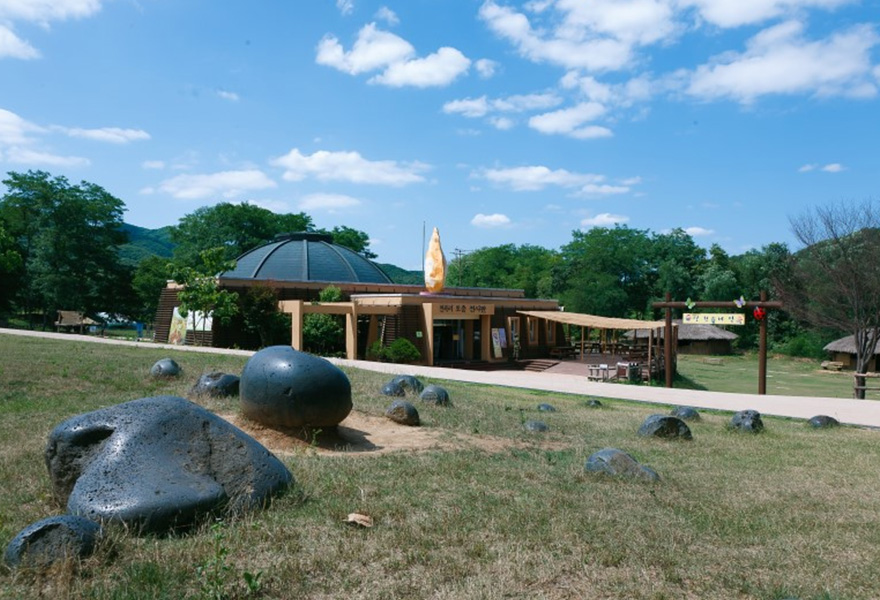Representative
Geosite
Representative
Geosite
Jeongokri ruins soil stratum
- Samtong(Gush-Out Water)
- Soisan Mountain(Cheorwon Lava Land)
- Jiktang Waterfall
- Goseokjeong
- Sambuyeon Falls
- Hwajeogyeon
- Mt. Jijang tuff
- Bidulginang Falls and Meonguri canyon
- Pocheon Auraji pillow lava
- Art Valley and Pocheonseok
- Jaein Falls
- Baekuiri Layer
- Jwasangbowi Rock
- Eundaeri Planticular Joint and Fold Structure
- Jeongokri ruins soil stratum

Jeongokri ruins are located in Jeon-gok-ri, Jeongok-eup, Yeoncheon-gun, Hantan River and leading ruins of Korea’s early Paleolithic era.
First discovered in 1978, these ruins were designated as the historical site No. 286 through the first archaeological excavation in 1979.
Jeongokri soil provides very important materials in studying old climate and old environment and correspond to geological attractions with a record of human development. Soil is classified into sand layer piled up by the activities of the river on basalt and clay layer estimated to have been stacked by the wind. About the origin of the clay layer, there are two theories by the wind and flooding of rivers but recently, a possibility was suggeted that the two origins are mixed to form.
In the clay layer, a dry crack phenomenon called soil wedge structure is observed and it is estimated to have been formed in the Ice Age and is used as an important indicator in studying old climate. Also, volcanic ash(Tephra) blown by the wind from Japan was found in soil layer, indicating that the top layer was deposited about 20,000 years to 100,000 years ago. As shown above, Jeongokri soil is archaeologically important and corresponds to a very important geological attraction in studying old climate geologically.
How was jeongokri ruins discovered at first?
These ruins of representing Paleolithic relics of Korea received attention as stoneware was discovered on the ground by a US soldier who visited Hantan River Amusement Part in 1977. This soldier named Greg Bowen took the taken stoneware to the late Seoul National University professor Kim Won-ryong and it became known as the old stone ruins receiving attention globally as revealed as Ashulian Paleolithic artifacts by professor Kim Won-ryong and Yeungnam University Professor Jeong Young-hwa. Yeoncheon Jeongokri ruins are located in south of Jeongok City, basalt plateau surrounded by Hantan River and granite and gneiss, metamorphic rocks formed during the Precambrian period constitute the bedrock and this rock formation was erupted in Gangwon Pyunggang region widely covered by basalt formed in the riverbed of Imjin River and Hantan River. Deposits of sand layer and red clay sedimentary layer are formed on basalt and top clay layer of these deposits is Paleolithic occupation layer and stoneware is discovered intensively.
From the discovery of Ashulian type stoneware such as hand ax and horizontal blade ax etc. in 1977 until now, the academic effort to clarify the nature of the historical sites has continued through the excavation over 11 times and about 3,000 artifacts were collected. As an opportunity to change the theory of Mobius that divided the Paleolithic culture into East Asia and Africa, Europe by the presence or absence of these stoneware until the end of the 1970's, the discovery of these stoneware opened the new horizon in the world Paleolithic Studies. It also aroused many attempts to understand the Paleolithic cultures of East Asia from a new angle and this became an opportunity to make Paleolithic research worldwide rich as well as Paleolithic research in Korea.
With the investigation of the ruins in Yeoncheon Jeongokri as a momentum, Quaternary geology research on the Hantan·Imjin River Basin was made and attention of geologists is still focused, providing an important venue of the study for the geological world.
The Prehistoric Experience Village is Jeongokri ruins’ own experience program that helps to understand the Paleolithic era when the human culture began to quicken through the experience. It consists of 6 programs such as Paleolithic Experience Zone, Paleolithic Barbecue Experience, Prehistoric Experience Travel leaving for Yeoncheon, Paleolithic archery, Paleolithic Archaeology Academy, Old Stone making Experience etc.
Sourced : http://exp.seonsa.go.kr